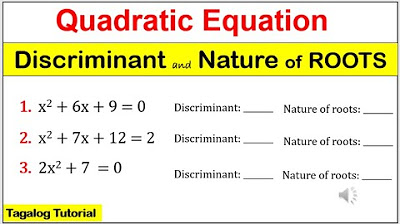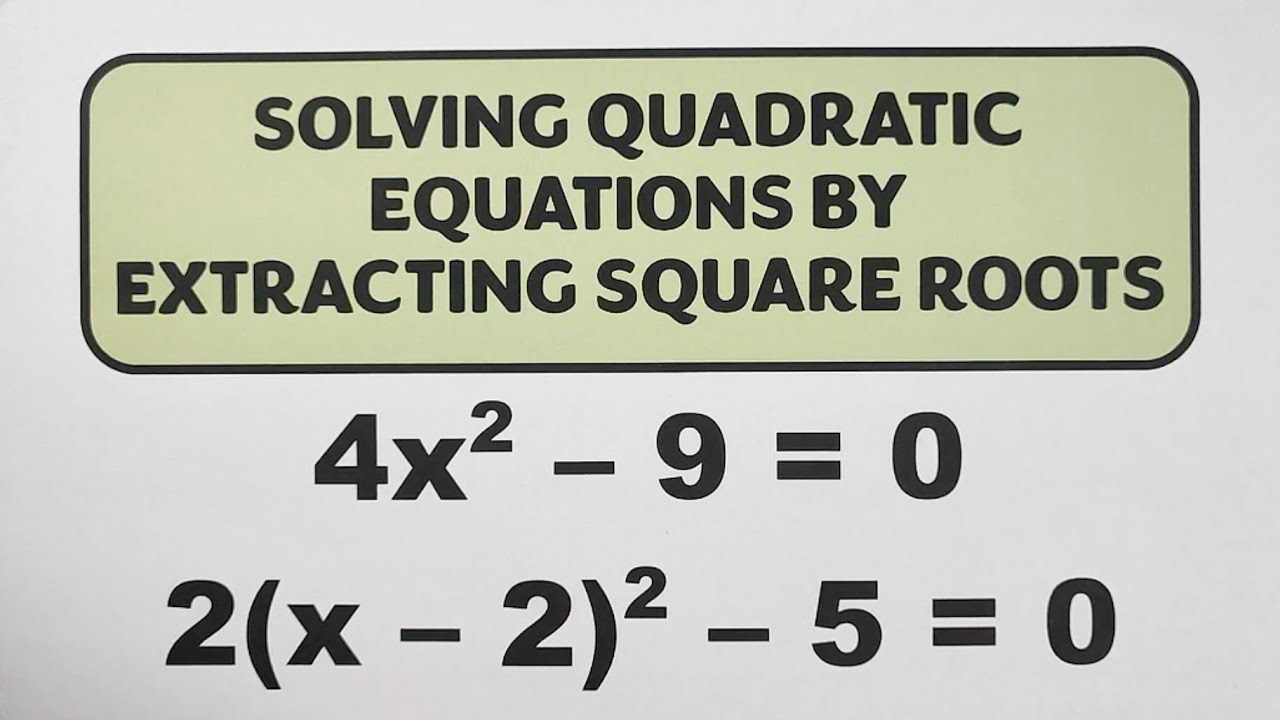Jenis-jenis akar persamaan kuadrat || akar real berbeda, akar real sama, akar tidal real (IMAJINER)
Summary
TLDRThis educational video explains how to solve quadratic equations by focusing on the nature of roots: real distinct, real equal, and non-real (imaginary) roots. The script covers several examples where the discriminant (D) is used to determine the types of roots. Viewers learn to identify the values of a, b, and c in the quadratic equation, apply the discriminant formula, and solve for the unknown variable. The video provides step-by-step instructions for each case, making it an accessible guide for understanding quadratic equations.
Takeaways
- 😀 Understanding the discriminant (D) is key to determining the nature of the roots in a quadratic equation.
- 😀 For quadratic equations with real and distinct roots, the discriminant (D) must be greater than 0.
- 😀 In the first example, the discriminant formula b^2 - 4ac is used to find that P must equal -12 for two distinct real roots.
- 😀 When quadratic equations have real and equal roots, the discriminant must be equal to 0.
- 😀 In the second example, solving for M involves setting the discriminant to 0, leading to two possible values for M: 0 and 1/2.
- 😀 For quadratic equations with imaginary roots, the discriminant (D) must be less than 0.
- 😀 In the third example, the discriminant formula is applied to find that the value of K must satisfy D < 0 for imaginary roots.
- 😀 The second example demonstrated how to factor a quadratic expression to find M, starting from the equation 16m^2 - 8m = 0.
- 😀 A crucial tip in solving quadratic inequalities is recognizing that values within the inequality must be tested for positivity or negativity to find valid solutions.
- 😀 The third example illustrates how to apply factoring and test values to determine the range for K, ensuring that it falls within the correct inequality for imaginary roots.
Q & A
What is the condition for two real and distinct roots in a quadratic equation?
-The condition for two real and distinct roots in a quadratic equation is that the discriminant (D) must be greater than 0.
How do you calculate the discriminant of a quadratic equation?
-The discriminant (D) of a quadratic equation ax² + bx + c = 0 is calculated using the formula D = b² - 4ac.
What does the term 'real and equal roots' mean in a quadratic equation?
-Real and equal roots occur when the discriminant (D) equals 0, meaning the quadratic equation has a single, repeated real root.
How can we determine if a quadratic equation has imaginary roots?
-A quadratic equation has imaginary roots if the discriminant (D) is less than 0.
What are the values of 'a', 'b', and 'c' in the quadratic equation x² + 6x - p + 3 = 0?
-'a' is 1 (coefficient of x²), 'b' is 6 (coefficient of x), and 'c' is -p + 3 (constant term).
How do you find the value of 'p' for the equation x² + 6x - p + 3 = 0 to have distinct real roots?
-To ensure distinct real roots, the discriminant D must be greater than 0. After calculating the discriminant, solving for p gives p = -12.
What is the discriminant condition for a quadratic equation to have real and equal roots?
-For real and equal roots, the discriminant (D) must be equal to 0.
In the quadratic equation x² - 4mx + 2 = 0, how do you find the value of 'm' for real and equal roots?
-For real and equal roots, set the discriminant D = 0. After applying the discriminant formula, solving gives m = 0 or m = 1/2.
In the quadratic equation kx² - 2kx - 6x + 1 = 0, what condition is needed for imaginary roots?
-Imaginary roots occur when the discriminant (D) is less than 0. This is achieved by solving the discriminant and ensuring it is negative.
What are the steps to solve for 'k' in the equation kx² - 2kx - 6x + 1 = 0 to get imaginary roots?
-First, calculate the discriminant D, then set it less than 0. Solving the resulting inequality gives k values in the range k > 4 or k < 9.
Outlines

Cette section est réservée aux utilisateurs payants. Améliorez votre compte pour accéder à cette section.
Améliorer maintenantMindmap

Cette section est réservée aux utilisateurs payants. Améliorez votre compte pour accéder à cette section.
Améliorer maintenantKeywords

Cette section est réservée aux utilisateurs payants. Améliorez votre compte pour accéder à cette section.
Améliorer maintenantHighlights

Cette section est réservée aux utilisateurs payants. Améliorez votre compte pour accéder à cette section.
Améliorer maintenantTranscripts

Cette section est réservée aux utilisateurs payants. Améliorez votre compte pour accéder à cette section.
Améliorer maintenantVoir Plus de Vidéos Connexes

Nature of Roots - Examples | Quadratic Equations | Don't Memorise

Class 10 CBSE - Concept of Quadratic Equations in 20 Min | Xylem Class 10 CBSE

Matematika SMA - Persamaan Kuadrat (4) - Diskriminan Persamaan Kuadrat, Soal Diskriminan (A)

Mudah Dipahami!!! Pemfaktoran Persamaan Kuadrat

MATH9 DISCRIMINANT and NATURE OF ROOTS of quadratic equation #math9 #discriminant #natureofroots

Solving Quadratic Equations by Extracting the Square Roots by @MathTeacherGon
5.0 / 5 (0 votes)
